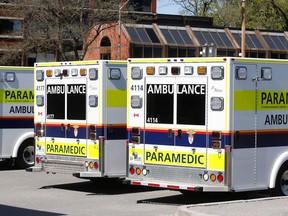The report notes that while paramedics did not meet the benchmarks for life-threatening and urgent cases, response-time performance improved slightly in 2023 compared to previous years.

Article content
For the third consecutive year, paramedics in Ottawa failed to meet city council’s targeted response times for the most critically ill patients, but they say a new system to dispatch calls could turn the tide.
“In 2023, the Ottawa Paramedic Service continued to experience challenges affecting overall service delivery to the community including increased response volume, increased hospital offload delay, and occurrences of level zero events, all of which pose a risk to public health and safety,” the service’s 2023 annual report reads.
Advertisement 2
Story continues below
Article content
Offload delay occurs when paramedics are not able to immediately offload a patient from ambulance to hospital, and level zero occurs when there are no ambulances available to transport a patient to hospital.
Council sets benchmarks for targeted response times for paramedics. For life-threatening cases, an ambulance should arrive within eight minutes for 75 per cent of calls. In 2023, paramedics met that response time for only 68 per cent of calls. Similarly, for “urgent” cases, paramedics should arrive on the scene within 10 minutes for 75 per cent of calls. In 2023, that only happened for 68.8 per cent of all calls. For lower-acuity cases, though, paramedics met the council-approved response times more than 75 per cent of the time.
“This can be attributed to annual increases in overall service demand and the excessive amount of time paramedics continue to spend in offload delay at Ottawa hospitals which depletes the availability of paramedic resources in the community,” the report reads.
The report notes that while paramedics did not meet the benchmarks for life-threatening and urgent cases, response-time performance improved slightly in 2023 compared to previous years. Additionally, the paramedic service also did not meet the legislated response time for sudden cardiac arrest patients.
Advertisement 3
Story continues below
Article content
“This can be attributed to the excessive amount of time the Ottawa Paramedic Service spent in offload delay at Ottawa hospitals and the 1,672 times the service was at level zero,” the report says.
Level zero cases, when there are no ambulances available to respond to 911 calls, were down slightly from 2022 when there were 1,819 such occurrences. A year earlier, there had been 750 level zero events in the city.
The report says the Ottawa Central Ambulance Communications Centre also did not meet call processing times for life-threatening or urgent calls, as well as sudden cardiac arrest patients.
“This is consistent with performance outcomes from previous years and can be attributed to increases in response volume and the use of the Dispatch Priority Card Index, an outdated call triage tool developed in the 1980s, which will be replaced with the Medical Priority Dispatch System in April 2024,” the report reads. “Steady increases in response volume and offload delay, combined with occurrences of level zero and pre-existing issues affecting Ontario’s healthcare system continue to negatively impact the Service, its staff, and its patients.”
Advertisement 4
Story continues below
Article content
The report says the new priority dispatch system is “a world-wide industry best practice used in over seventy countries for call assessment and prioritization,” with an algorithm that “provides greater precision, accuracy and efficiency in triaging calls” compared to the previous system, “and is significantly better at determining response requirements for all calls including the most severely ill or injured patients.”
The city launched the new dispatch system on April 10, and now ambulances are dispatched based on answers to detailed questions, and according to five colour-based levels based on the “acuity” of the situation, as determined during the 911 call.
The new system means top-priority calls will be marked “purple,” indicating immediate life-threatening conditions where time is critical. This accounts for about two per cent of calls. Next on the priority list is “red,” meaning emergent and potentially life-threatening, representing about 38 per cent of calls. Time is sensitive in these cases. “Orange” is urgent and potentially life-threatening. Time may be a factor. This accounts for 17 per cent of calls. “Yellow” is non-urgent, but potentially serious. Time is sensitive. It’s about 19 per cent of calls.
Advertisement 5
Story continues below
Article content
“Green” is non-urgent and not serious, with no immediate threat to life, and it may be deferred without detriment to the patient’s outcome. This is about 24 per cent of calls.
Under the old system, high priority was assigned to 77 per cent of calls, though only about two per cent of calls fit in “purple,” Pierre Poirier, chief of the Ottawa Paramedic Service, told city councillors on the emergency preparedness and protective services committee in March.
In 2023, the Ottawa Paramedic Service response volume was 193,127, representing a 4.9 per cent increase over 2022.
With the exception of 2020, the report notes response volume continues to increase year over year, with the most significant increase taking place in 2022.
“Over the past 10 years, response volume has increased by an average of 5.2 per cent per year. Annual increases in response volume can be attributed to several factors including population growth, an aging patient demographic, increasingly complex patient clinical presentations, and pre-existing issues affecting Ontario’s healthcare system which have been exacerbated by the COVID-19 pandemic. As such, in 2023, the Ottawa Paramedic Service experienced difficulty achieving legislated response time performance standards and Council-approved targets.”
The annual report will be presented to the city’s emergency preparedness and protective services committee on June 17 and goes to council on June 26.
— With files from Postmedia
Our website is your destination for up-to-the-minute news, so make sure to bookmark our homepage and sign up for our newsletters so we can keep you informed.
Recommended from Editorial
Article content


Comments